Air Operations, Carolines - XIII Bomber Command B-24s attack the airfield on Peleliu in the Palau Islands.
- 34 XIII Bomber Command B-24s attack the Truk Atoll.
- During the night, VII Bomber Command B-24s attack the Truk Atoll.
[  | |   ] ]
Air Operations, CBI
BURMA
- 23 7th Heavy Bomb Group B-24s attack Chauk, Lonywa, and Yenangyaung.
- More than 50 10en Air Force fighter-bombers attack Mogaung, Myitkyina, and Tapo.
CHINA
- 14th Air Force B-25s and P-40s attack Japanese Army cavalry, fortifications, tanks, and barracks at Ichang and Lingpao.
- More than 80 P-38s, P-40s, and P-51s attack numerous targets throughout the Tungting Lake region.
- 449th Fighter Squadron P-38s down 2 Ki-44 'Tojo' fighters near Anking between 0940 and 0955 hours.
- 5th CACW Fighter Group P-40s down 2 D3A 'Val' dive bombers near Kunming during the late afternoon.
INDIA
- 30 10th Air Force B-25s airlift ammunition to Imphal.
[  | |   ] ]
Air Operations, Europe (Return flight?)The Rumanian airfield at Focsani is raided by planes from 15th Air Force from Italy. After bombing the planes fly on to Russia. This is the first 'shuttle' raid of this pattern.
RAF BOMBER COMMAND
Evening Ops:
- 329 aircraft of Nos. 1, 3, 4 and 8 Groups attack railway targets at Évreux, Massey Palaiseau, Nantes and Tours. In this total are 225 Lancasters, 86 Halifaxes and 18 Mosquitos. All the raids appear to have been successful.
- 3 Lancasters and 1 Halifax are lost; 1 from each raid.
Evening Ops:
- 33 Mosquitos are sent to Berlin, 13 Halifaxes lay mines on the flanks of the invasion area and there are 30 Serrate patrols.
- 2 Mosquitos are lost on the Berlin raid.
US 8th AIR FORCE
FRANCE:
- Bad weather cancels scheduled attacks on targets in Germany, but, of 1,055 8th Air Force B-17s and B-24s dispatched, a total of 606 form into small tactical formations attack ten Luftwaffe airdromes and numerous rail targets in Brittany, the Loire River valley, and around Paris.
- 2 B-17s and 1 B-24 are lost
- VIII Fighter Command fighters mount 914 effective sorties while escorting the heavy bombers, patrolling the beachhead area, and attacking a wide variety of communications targets in the Normandy area.
- 8 fighters and 7 pilots are lost
US 9th AIR FORCE
FRANCE:
- During the morning, a total of 129 IX Bomber Command B-26s and A-20s, along with 10 9th Air Force fighter-bomber groups, attack rail and road targets, oil tanks, gun emplacements, and defended town areas.
- 356th Fighter Group P-47 pilots down 2 Luftwaffe fighters near Bernay about 0700 hours.
- 55th Fighter Group P-38 pilots down 8 Luftwaffe fighters over northwestern France between 1500 and 1615 hours.
US 12th AIR FORCE
ITALY:
- Bad weather grounds all of the bombers of the 12th Air Force, but a small number of XII TAC fighters and fighter-bombers attack rail and road targets and motor vehicles.
US 15th AIR FORCE
ROMANIA:
- While escorting 15th Air Force B-24s on a mission against oil-industry targets at Constanta and Giurglu, 14th Fighter Group P-38 pilots and 52nd Fighter Group P-51 pilots down 18 Axis fighters over Romania between 0845 and 0935 hours.
- 15th Air Force B-17s returning from the inaugural FRANTIC mission to the Soviet Union attack the Axis airdrome at Foscani. 325th Fighter Group P-51 escort pilots down 3 Bf-109s between 0940 and 1045 hours.
YUGOSLAVIA:
- 15th Air Force B-17s attack oil-industry targets and a marshalling yard at Smederevo.
[  | |   ] ]
Air Operations, Marianas - As Task Force 58 makes its final approach on the Marianas to commence Operation FORAGER, 2 VF-50 F6Fs down a D4Y 'Judy' dive bomber at sea at 0605 hours.
- A VF-1 F6F downs an H8K 'Emily' flying boat at sea 70 miles from the task force at 1220 hours.
- A VF-1 F6F downs a Ki-48 'Lily' bomber at sea 25 miles from the task force at 1245 hours.
- A VF-2 F6F downs another H8K 'Emily' flying boat at sea 50 miles from the task force at 1250 hours.
- A VF-1 F6F downs an H8K 'Emily' at sea 50 miles from the task force at 1300 hours.
- A VF-14 F6F downs a twin-engine airplane at sea at 1300 hours.
- A VF-2 F6F downs a G4M 'Betty' bomber at sea 50 miles from the task force at 1310 hours.
- Beginning at 1430 hours, 208 F6F fighter-bombers and 8 TBM command aircraft from Task Force 58 carriers open the pre-invasion bombardment against Japanese bases in the Marianas, beginning with sweeps against Guam, Saipan, Pagan, Rota, and Tinian. The US Navy aircraft quickly gain air superiority over the islands at a cost of 11 F6Fs with 8 pilots lost. An estimated 100 to 150 Japanese aircraft are destroyed on the ground.
- Between 1345 and 1530 hours, as F6Fs attack shipping, airfields, and ground targets on Saipan, Tinian, and Guam, F6Fs and FMs down 81 Japanese fighters (nearly all A6M Zeros), 3 G4M 'Betty' bombers, 4 H8K 'Emily' flying boats, and 1 H6K 'Mavis' flying boat. Among the Japanese Navy fighters downed is 1 J2M 'Jack' fighter, the first of this new type to be encountered by US pilots in the war.
- A VF-8 F6F downs 1 Ki-61 'Tony' fighter at sea 45 miles from Task Force 58 at 1545 hours and a VF-8 F6F downs 1 B6N 'Kate' torpedo bomer at sea 30 miles from the task force at 1630 hours.
[  | |   ] ]
Air Operations, New Guinea - V Bomber Command B-24s attack the Sorido airfield on Biak.
- 5th Air Force B-25s, A-20s, and P-47s attack targets throughout the Hansa Bay and Wewak area.
[  | |   ] ]
Atlantic - US LST-496 sinks when it hits a mine in the Normandy area.
- The US ocean tug Partridge (ATO-138) is sunk by torpedo in the Normandy area delivered by German torpedo boats attacking invasion shipping. Damaged in these attacks is the tank landing ship LST-538 and the destroyer Nelson (DD-623).
- The infantry landing craft LCI-219 is sunk by aircraft.
[  | |   ] ]
Battle of the Atlantic Canso 'B' of No 162 Squadron RCAF sights a U-boat on the surface at 1515 hours and immediately attacks dropping four depth charges. When the explosions subside U-980
is seen trailing oil, although it continues to engage the aircraft with flak until it is seen to sink at 1532 hours.
U-980|
| Class | Type VIIC |
| CO |
Kapitänleutnant Hermann Dahms |
| Location |
North Sea |
| Cause |
Air attack |
| Casualties |
52 |
| Survivors |
None |
|
U-490|
| Class | Type XIV |
| CO |
Oberleutnant Wilhelm Gerlach |
| Location |
Atlantic, NW of the Azores |
| Cause |
Depth charge, gunfire |
| Casualties |
None |
| Survivors |
53 |
|
The last remaining supply U-boat, U-490, is sunk in the North Atlantic area by aircraft (VC-95) from the US escort carrier Croatan (CVE-25) and the destroyer escorts Frost (DE-144), Huse (DE-145) and Inch (DE-146).
[  | |   ] ]
CBI
CHINA
The Japanese penetrate in force across the Liu-yang River, meeting little resistance from the Chinese forces in the IX War Zone.
[  | |   ] ]
Eastern Front Following up their offensive against the Mannerheim Line, the Leningrad Front armies penetrate 15 miles into the Finnish lines on a front of 30 miles. The Finnish 10th Div retreats behind the 'VT Line' (Vammelsuu-Taipale) across the Karelian Isthmus.
FINNISH SECTOR
The 23rd Army joins the offensive. Fighting is bitter as the heavily outnumbered Finns fight to halt the Soviet onslaught. Despite repeated counterattacks each Finnish position is overwhelmed, Soviet forces drawing close to the second defense line. By evening the first defense line collapses, forcing the Finns northward.
[  | |   ] ]
Italy In the French Expeditionary Corps sector the 1st Motorized Div captures Montefiascone, west of Viterbo, and the 3rd Algerian Div enters Valentano. The South African 6th Arm Div fails to overcome German resistance below Bagnoregio. Another armored division, the British 6th, crosses the Galantina River and reaches Cantalupo, which the Germans have already abandoned.[ITALY]
[  | |   ] ]
Marianas Vice-Adm Mitscher's TF 58 with 9 fleet and 6 light carriers sends fighter strikes against Japanese shipping and installations on Saipan, Tinian, Guam, Pagan and Rota in the Marianas group. 36 Japanese planes are shot down. The 7 battleships of Adm Lee's TG 58.7 provide close escort. Japanese shipping also comes under attack from TG 58.4. 3 minor warships and 30,000 tons of merchant shipping are sunk by the aircraft. The operations continue. Adm Spruance, in overall command of the Marianas campaign, is present on board the cruiser Indianapolis. Over the next 3 days the Americans win complete air superiority, bringing down or destroying on the ground between 150 and 200 Japanese aircraft.
[ | |   ] ]
Molucca Islands Vice-Adm Matome Ugaki, commander of the Japanese fleet at sea, orders the 2 giant battleships Yamato and Musashi (72,800t fully laden) with cruiser and destroyer escort to Bacan to strike a decisive blow at MacArthur's 7th Amphibious Force. But just as this powerful force is about to sail it receives orders to head for the Marianas.
[  ] ]
New Guinea The US 186th and 162nd Inf Regts go over to the attack and reach a point a little more than 1,000 yards from the west side of the runway on Mokmer airfield. Captured Javanese laborers speak of Japanese positions in caves about three-quarters of a mile northwest of units of the US 162nd Regt.
[  | |   ] ]
Pacific - The Japanese submarine RO-111 is sunk by the US destroyer Taylor (DD-468) north of the Bismarck Archipelago.
- The US submarine Barb (SS-220) sinks the Japanese merchant fishing vessels Chihaya Maru (1161t) and Toten Maru (3823t) in the sea of Okhotsk east of Karafuto.
- The US submarine Redfin (SS-272) sinks the Japanese tanker Asanagi Maru (5142t) west of Jolo, Philippines.
[  | |   ] ]
Western Front While the US 90th Div continues its slow advance west of the Merderet River, the 101st Airborne Div mounts the decisive attack on Carentan. During the night, under deadly fire from the American artillery, the Germans leave the town. Carentan is occupied, but it is not long before the enemy endeavors to re-take it.
In the US V Corps sector units of the 2nd Arm Div are ordered to reinforce the bridgehead at Auville-sur-le-Vey as long as the 101st Airborne Div continues to be engaged at Carentan. There is a lull on the rest of the US V Corps front.[WF]
The 7th Arm Div, XXX Corps, British 2nd Army, encounters fierce resistance around Tilly-sur-Seulles from the German Panzerlehr Div, which takes advantage of the vegetation and the nature of the terrain to adopt guerrilla tactics, lying concealed, advancing rapidly, then retiring unexpectedly. The British manage to take Tilly, but then a sudden German counterattack drives them from the village. East of Caen, too, where the British I Corps is operating, the Allied situation is difficult; counter-attacks here by the German LXXXVI Corps have halted their advance.[CAEN]
[  | |   ] ]
Images from June 11, 1944
Watching for the Enemy
|
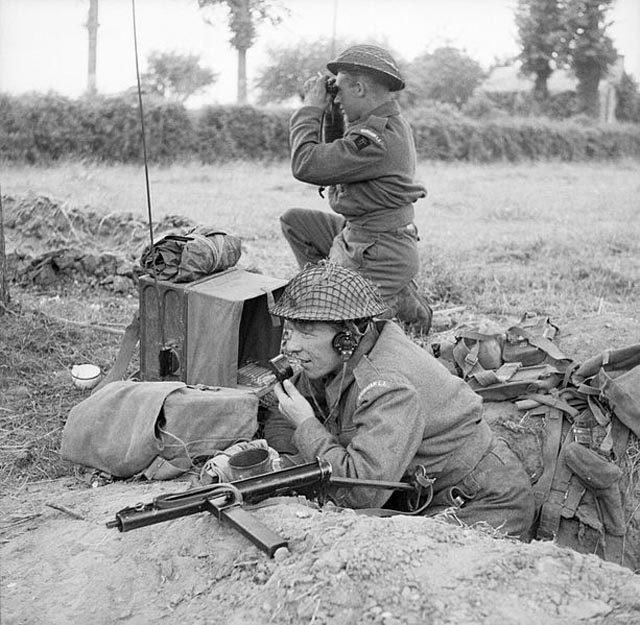 |
|
Sherman Tanks Passing Through Reviers
|
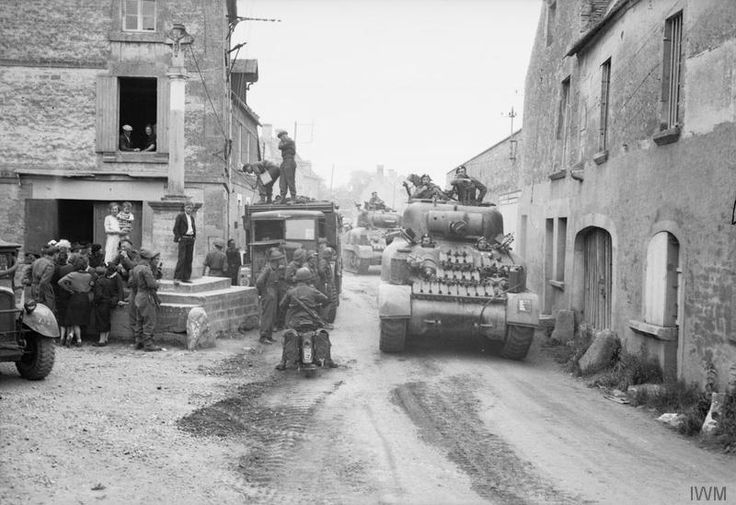 |
|
Help From German POWs
|
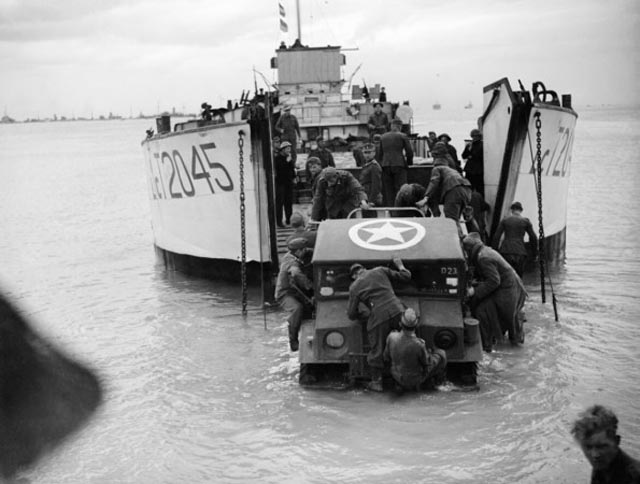 |
|
British Troops in Douet
|
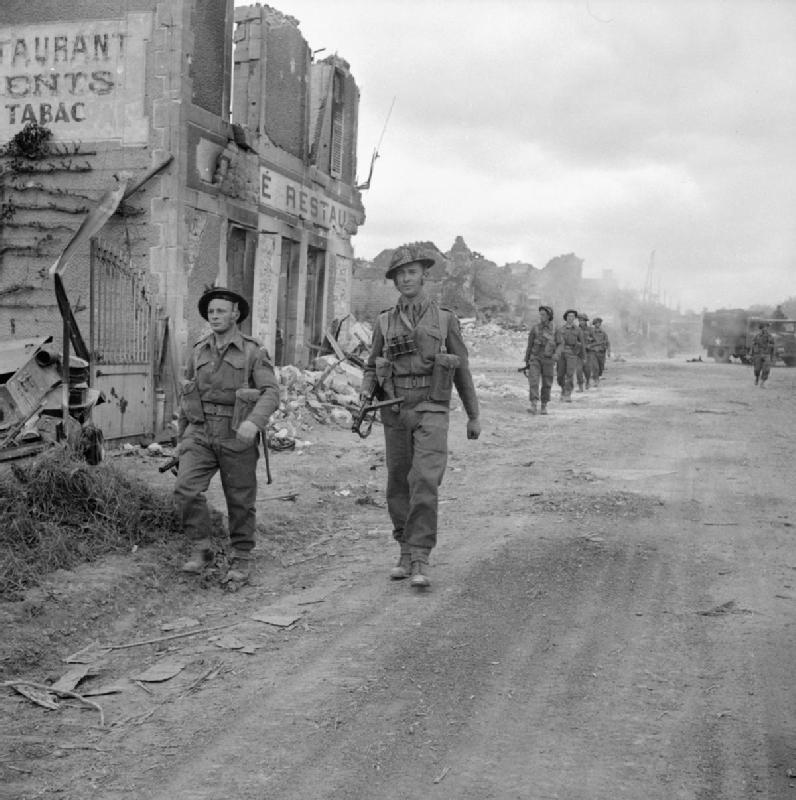 |
|
Courseulles-sur-Mer
|
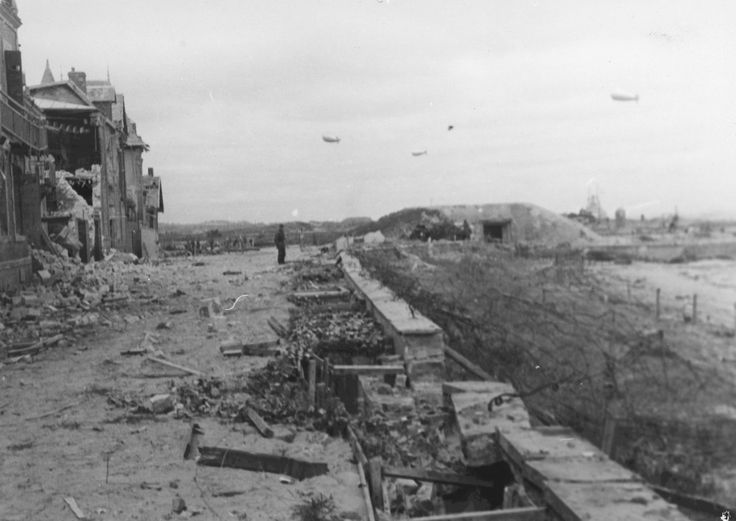 |
|
Courseulles-sur-Mer in Ruins
|
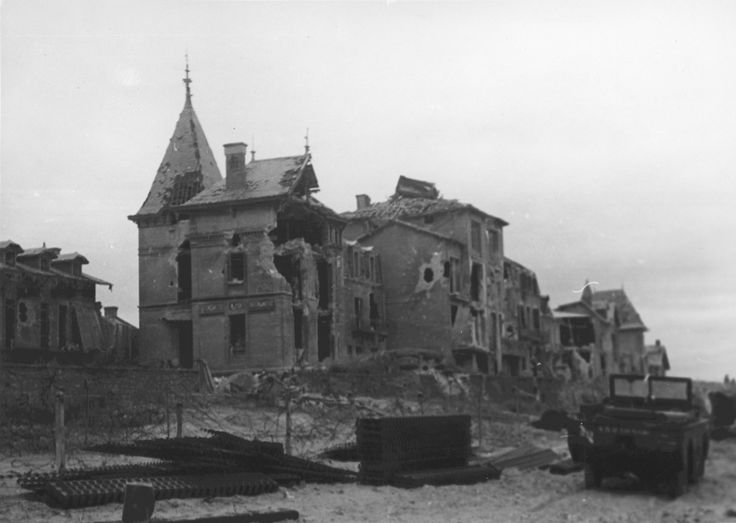 |
|
Gathering a Wheat Harvest
|
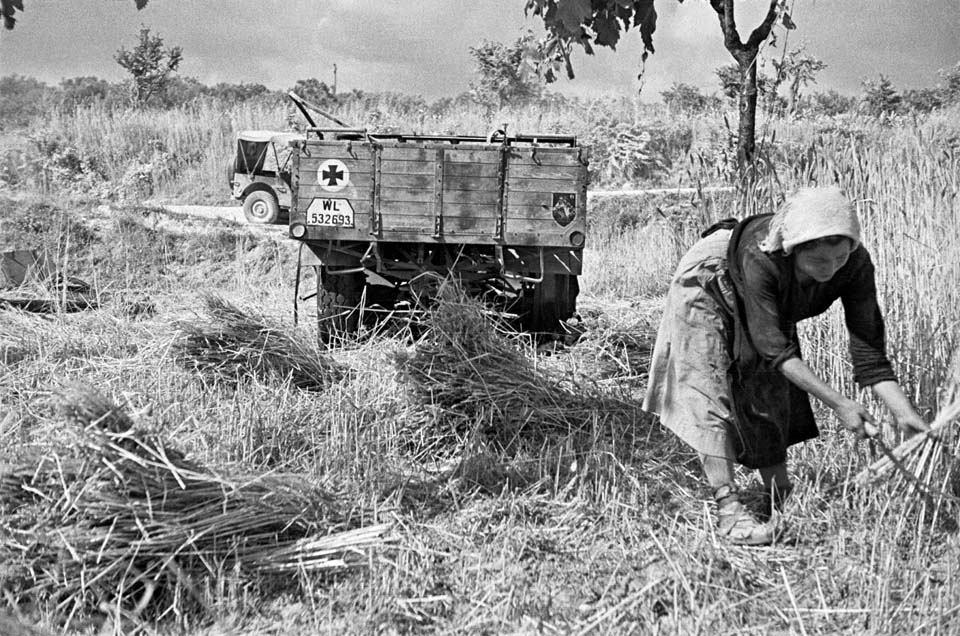 |
|
The Duchess of Kent Visits
|
 |
|
Sleeping in a Foxhole
|
 |
|
GIs in Main Street of Isigny
|
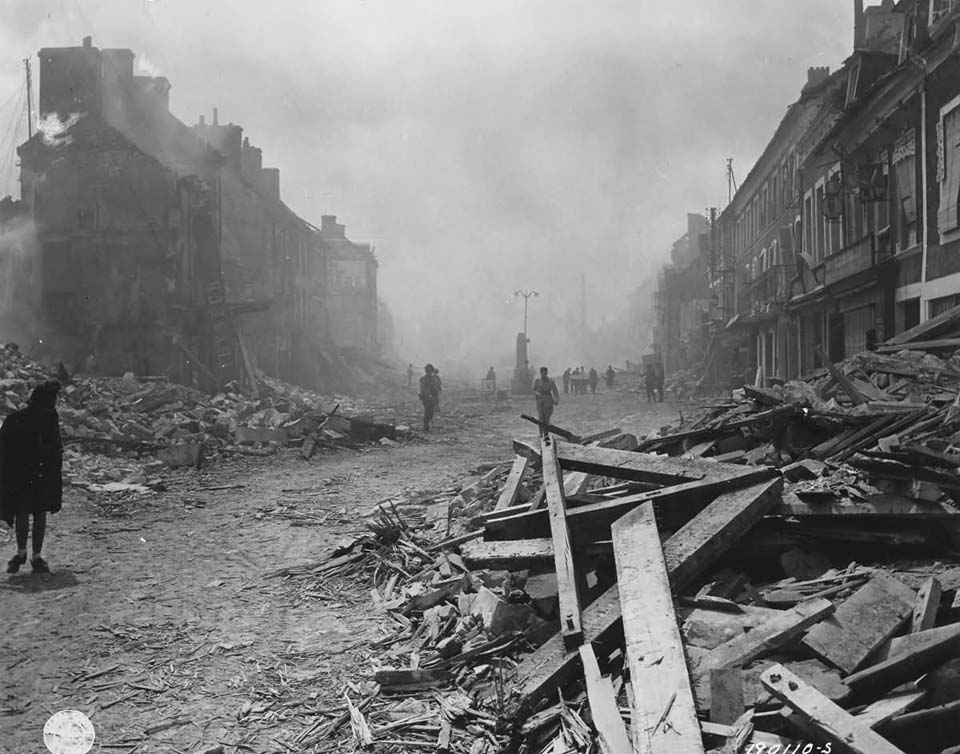 |
|
Writing a Letter Home
|
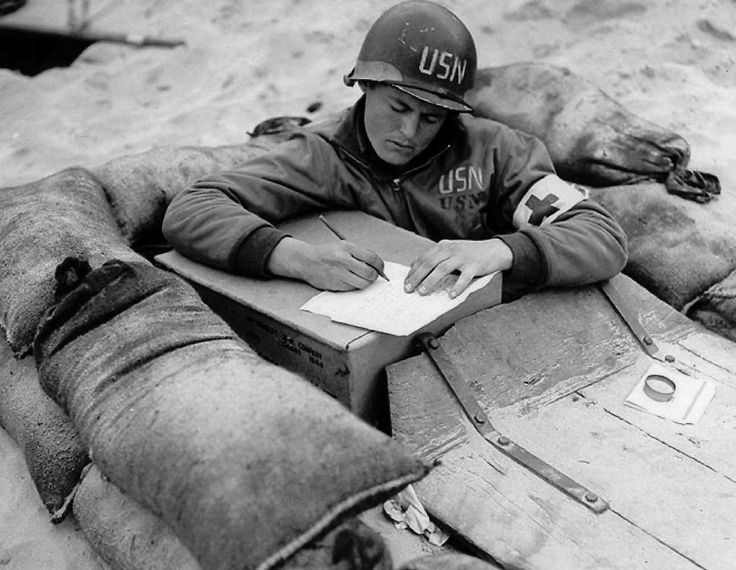 |
|
'Rhino' Ferry Vessel
|
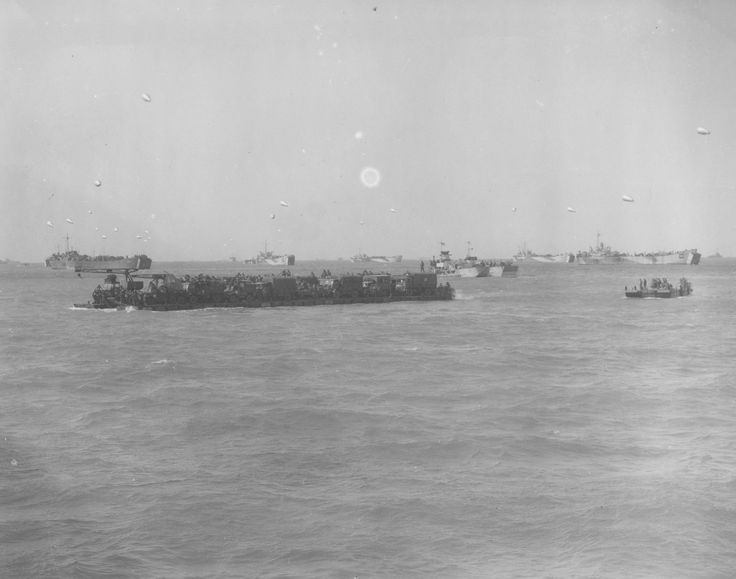 |
|
|











